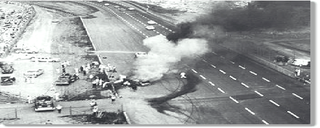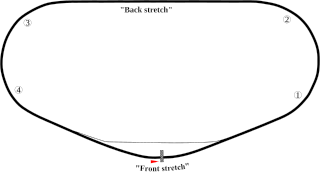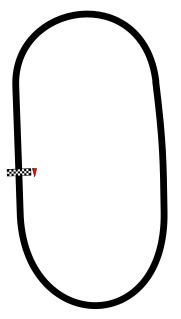Related Research Articles

The 1966 NASCAR Grand National Series evolved into the first of three NASCAR Grand National championships for David Pearson, whose 15 wins through the season was second only to Tim Flock's 18 victories in 1955 at that time. NASCAR allowed the return of the Chrysler Hemi engine in 1966, and at the same time Ford decided to boycott NASCAR for the season. Pearson captured the championship with 35,638 points over second place James Hylton who finished the season with no wins, but 33,638 points for his consistency and efforts.
The 1964 Textile 250 was a NASCAR Grand National Series event that was held on November 10, 1963, at Concord Speedway in Concord, North Carolina.
The 1961 NASCAR Grand National season was the 13th season of professional stock car racing in the United States, and contested over 52 events from November 6, 1960, to October 29, 1961. Ned Jarrett captured the championship which was run on 20 dirt tracks, 31 paved tracks, and one road course. Seventeen events were considered short tracks, and 14 events were held at super speedways. Joe Weatherly won the season opening's event at Charlotte, and Jarrett went on to capture the championship with 27,272 points; 830 more than second-place finisher Rex White. Emanuel Zervakis finished third in points, with Joe Weatherly fourth and Fireball Roberts fifth.

The 1968 Northern 300 was a NASCAR Grand National Series event that was held on July 14, 1968, at Trenton Speedway in Trenton, New Jersey.
The 1968 Hickory 250 was a NASCAR Grand National Series event that was held on April 7, 1968, at Hickory Speedway in Hickory, North Carolina.
The 1967 Fireball 300 was a NASCAR Grand National Series event that was held on March 7, 1967, at Asheville-Weaverville Speedway in Weaverville, North Carolina.
The 1963 Sandlapper 200 was the site of Richard Petty's 25th NASCAR Grand National win for Petty Enterprises.
The 1963 NASCAR Grand National Series was an American stock car racing competition. It was the fourteenth running of what is now called the Monster Energy NASCAR Cup Series.

The 1964 World 600, the fifth running of the event, was a NASCAR Grand National Series event that took place on May 24, 1964, at Charlotte Motor Speedway in Concord, North Carolina.
The 1968 Western North Carolina 500 was a NASCAR Grand National Series event that was held on August 18, 1968, at Asheville-Weaverville Speedway in Weaverville, North Carolina.

The 1965 Southern 500, the 16th running of the event, was a NASCAR Grand National Series event that was held on September 6, 1965, at Darlington Raceway in Darlington, South Carolina.

The 1966 Firecracker 400 was a NASCAR Grand National Series event that was held on July 4, 1966, at Daytona International Speedway in Daytona Beach, Florida.

The 1965 Virginia 500 was a NASCAR Grand National Series event that was held on April 25, 1965, at Martinsville Speedway in Martinsville, Virginia.
The 1961 Buddy Shuman 250 was a NASCAR Grand National Series event that was held on September 8, 1961, at Hickory Speedway in Hickory, North Carolina.
The 1966 Columbia 200 was a NASCAR Grand National Series event that was held on April 7, 1966, at Columbia Speedway in Columbia, South Carolina.

The 1962 Southern 500, the 13th running of the event, was a NASCAR Grand National Series event that was held on September 3, 1962, at Darlington Raceway in Darlington, South Carolina.
The 1956 Buddy Shuman 250 was a NASCAR Grand National Series event that was held on November 11, 1956, at Hickory Speedway in Hickory, North Carolina.

The 1967 Gwyn Staley 400 was a NASCAR Grand National Series event that was held on April 16, 1967, at North Wilkesboro Speedway in North Wilkesboro, North Carolina.

The 1967 Atlanta 500 was a NASCAR Grand National Series event that was held on April 2, 1967, at Atlanta International Raceway in Hampton, Georgia.

The 1962 Dixie 400 was a NASCAR Grand National Series event that was held on October 28, 1962, at Atlanta International Raceway in Hampton, Georgia.
References
| Preceded by 1966 Southern 500 | NASCAR Grand National Series season 1966 | Succeeded by 1966 Capital City 300 |